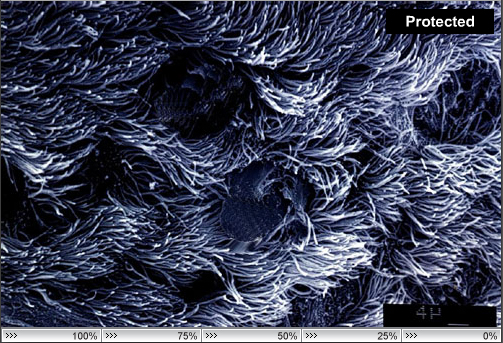The ciliostasis test – measuring protection against Infectious Bronchitis
The ciliostasis test evaluates the ciliary activity of the trachea.
Natural defence mechanism of the trachea
The trachea is equipped with a defence mechanism designed to protect the body against the invasion of pathogens. This mechanism is referred to as the mucociliary apparatus.
The surface of the trachea is covered with specialised epithelial cells, which are lined with numerous, motile, hair–like structures called cilia. Located between the cilia are secretory cells called “goblet cells”. The mucus produced by these secretory cells traps the foreign agents and then with the aid of the coordinated uni–directional motion of the beating cilia, the foreign material is removed.
The mucociliary apparatus is extremely important in controlling secondary respiratory pathogens (E. coli, Aspergillus sp., etc.). The loss of cilia (deciliation) results in a major disruption in the defence capability of the respiratory system. Accordingly, it is important that a vaccine virus should have little adverse effect on this important disease protection mechanism.
The ciliostasis test
The effect of a virus on the tracheal mucosa can be measured and two evaluations can be made:
- the pathogenicity of a (vaccine) virus can be measured in unvaccinated chickens.
- the level of protection can be measured in vaccinated chickens.
The test is carried out as follows:
- ten chickens are used per group.
- 5–7 days post challenge ten thin tracheal rings (3 from the top and bottom and 4 from the middle of the trachea) are selected from each bird.
- the rings are observed for ciliary activity using a microscope.
- ciliary activity is scored on a scale from 0 (100% of cilia beating) to 4 (0% of cilia beating).
Microscopic examination of tracheal cilia
Percentage values indicate activity of the cilia. Click on each value to see how the activity of the cilia is affected following IB infection. When cilia activity is reduced to 50% or below the trachea is no longer protected against for example secondary bacterial infection.

The ciliostasis score for each chicken is the total score for 10 tracheal rings:
- If complete ciliostasis is observed (0% of cilia are active) a maximum score of 40 is given indicating no protection.
- If 50% or more of the cilia are active, a score of less than 20 is given indicating protection.
- When evaluating the level of protection in vaccinated birds, the lower the score, the higher the degree of (cross) protection provided by the vaccination program.
